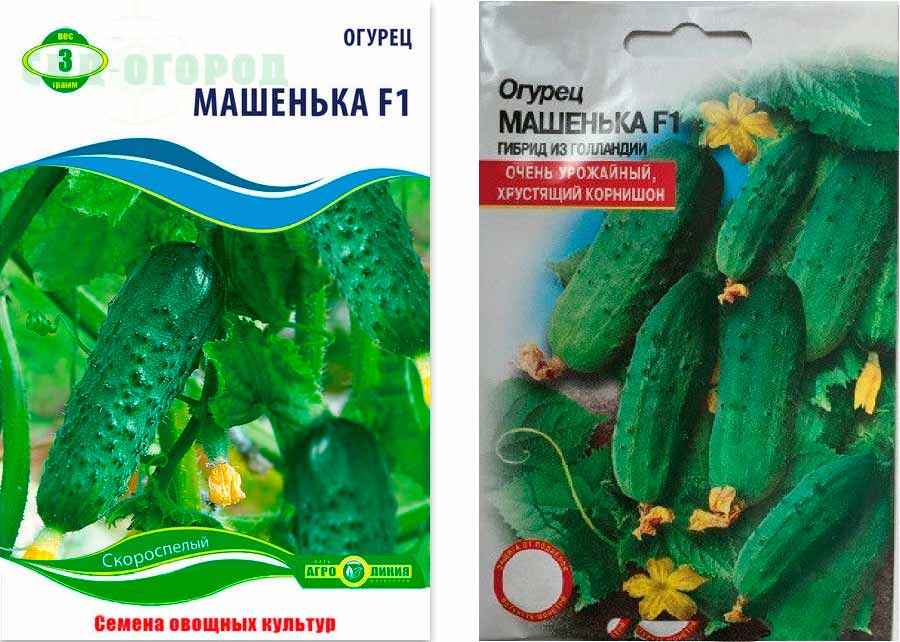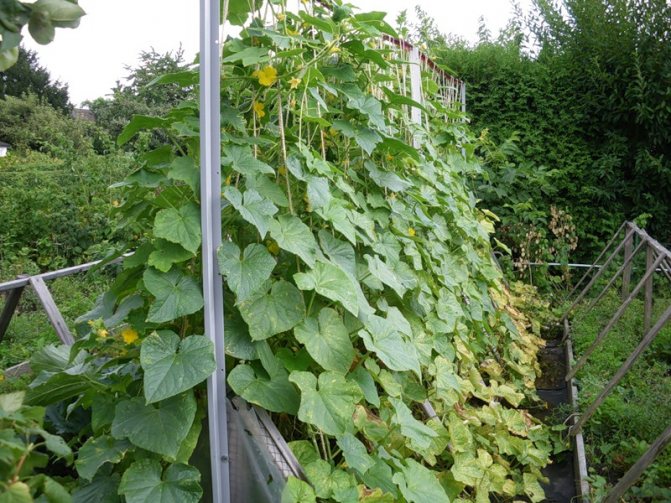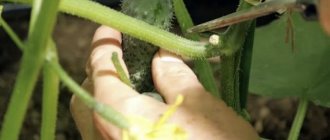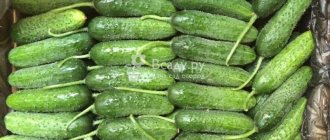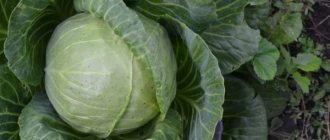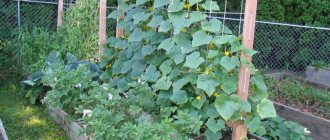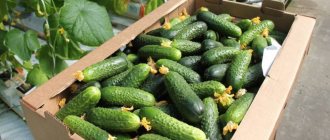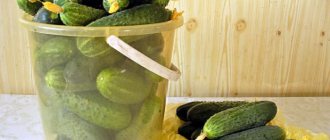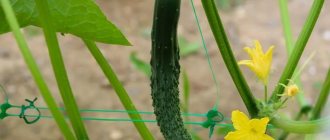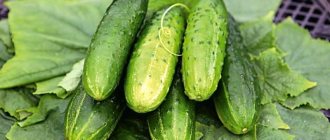Vegetable growing »Cucumbers
0
1614
Article rating
The most popular among the high-yielding early-ripening hybrids is the Masha cucumber variety. The combination of attractive appearance and excellent taste makes the variety attractive to many farmers. The main feature of the species is good preservation of external data and taste after collection.
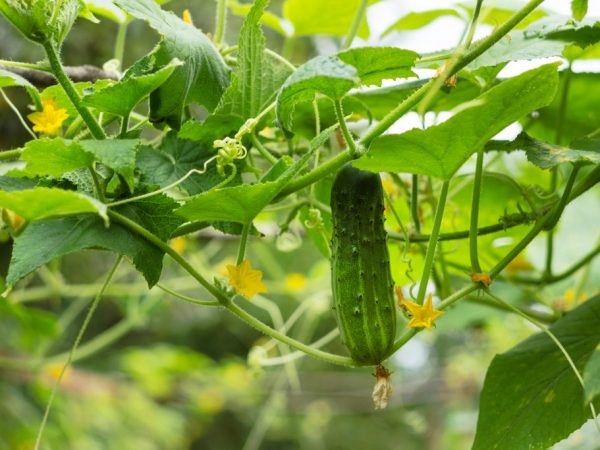
Description of the variety of cucumbers Masha
Characteristics of the variety
The country of origin is Holland. There is a note on the packages with the product description that the seeds do not need to be pre-treated with disinfectants because the planting material has already been treated by the manufacturer. Dutch breeders gave our farmers the opportunity to grow a quality product in greenhouse conditions and in the open field of the southern regions.
Cucumber variety Masha f1 is a self-pollinated hybrid of the first generation. The characteristic of biological characteristics describes the first generations of plants from two parental species, as highly resistant to diseases, characterized by good endurance, high-yielding specimens. It is important to remember that the seeds that F1 hybrid gives are not suitable for growing. During subsequent cultivation, the plants do not retain the properties of the parental species.
If you follow all agrotechnical rules, you can get from 1 branch to 5 zelents. From 1 m2, 15 kg of cucumbers can be harvested when grown in greenhouse conditions. In the open field, the yield is slightly less - 10-12 kg per 1 m2. Fruits ripen 36 days after germination
Description of the plant
Cucumber Masha f1 - a description of the features of the appearance of the plant:
- determinant bush;
- the growth of the main stem is limited by the inflorescence;
- shoots are poorly formed, which simplifies the formation of bushes;
- there can be up to 7 ovaries in a knot;
- foliage is green, medium-sized, wrinkled.
Description of the fetus
Masha cucumbers have a cylindrical shape. The structure of the skin is pimply, dense. The mass of greenery is 90-100 g. The length of the fruit is 11 cm. Cucumbers of our Masha variety, according to the manufacturer's description, are included in the State Register of Russia as a universal species that can be used for preservation and salads.
The pulp has a pleasant aroma. The taste is sweet, without bitterness. When salted, Baba Masha cucumbers do not lose their elasticity, remain crispy, without forming a void inside.
Testimonials
Anastasia Gorobets, 45 years old
Cucumbers Masha F1 I have been planting for more than a year. I buy seeds from. Germination rate is 100% and disease resistance is really high. We harvest all summer, eat fresh, salt, pickle. The cucumber is tasty, strong, but not aromatic enough and the skin is thick. Chose this hybrid for its drought tolerance. Our soil is sandy, there is little moisture, it is possible to water it 1-2 times a week. Many cucumbers dry up, but "Masha" is doing well!
Vladimir Artemiev, 32 years old
We have a small polycarbonate greenhouse, so we try to plant only proven varieties of cucumbers and tomatoes. From cucumbers I prefer "Masha" and "Marinda". Pollination is not required for them and special care too. Bushes of "Masha" themselves are quite compact, so you don't have to spend a lot of time on pinching and pinching. We tie the lashes to the trellis to make it easier to collect the greens.
Lyudmila Neklyudova, 64 years old
When my favorite cucumbers "Masha" begin to bear fruit actively, we move with the whole family to the dacha, because the gherkins have to be removed every day. The cucumbers are small, firm and firm. Eat fresh, salt and pickle for the winter. I don't even pre-soak those that have just been removed from the bush, I just wash them and put them in the banks. For flavor I add cherry and currant leaves, dill, horseradish, garlic and a little tarragon. Canned ones seem even tastier to me than fresh ones!
Maxim Stankovich, 51 years old
I begin to prepare the soil before planting Masha f1 cucumbers in the open field in the fall. For each square meter I bring in 3 buckets of manure, 1 liter of wood ash solution and 100 g of nitrophosphate. I dig up and loosen everything. In the spring, it is better to dig up again and form ridges. We prepare the seedlings at home, and plant them in the ground in the second decade of May (when the temperature is set above 18 degrees at night). I use the horizontal method (without trellises), so I plant no more than 2-3 bushes per square meter.
Ksenia Mayevskaya, 33 years old
The cucumbers are delicious, do not taste bitter at all, they all look "conditional" - the same size, dark green, even and strong. They suit me very well for canning. When the leaves begin to turn yellow on the lashes, I cut them off and pinch the growth point. I feed with urea. After that, fruiting begins with renewed vigor, the ovaries are laid in bunches of 5-6 pieces. "Masha" is a fruitful variety! We are happy!
Growing
Planting cucumbers Maria F1 is simplified by the manufacturer. The seeds do not require additional disinfection and soaking before planting. All that remains for farmers is to find a suitable site and take proper care of the plants. The variety is quite capricious and therefore not every site is suitable for growing it.
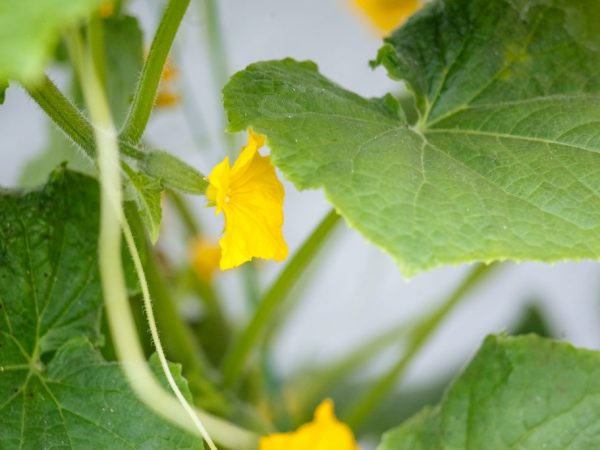

For a plant, you need to choose the right site
The landing area should be well lit, not blown by the winds. The plant bears fruit well on light soils enriched with humus, with a low acidity. The soil begins to be prepared in the autumn. You need to take care of thorough cleaning of plant residues, dig up the site and add organic matter.
It is possible to increase yields with strict adherence to the rules of crop rotation.
Then you can plant
Best predecessors for Mary:
- potatoes;
- onion;
- tomatoes;
- cabbage;
- winter crops;
- wheat;
- legumes.
It is strictly forbidden to plant the variety after beets and zucchini. These plants extract all the nutrients from the soil necessary for the full development of the culture. Planting is carried out only when the soil is fully warmed up in late May and early June. If you neglect these rules, seedlings will develop slowly, as a result, yield will decrease.
Landing
The seeding pattern depends on the location of the shoots and stems. Distinguish between vertical and horizontal fit. With the vertical version, 3 bushes are planted per 1 m2, with the horizontal - 4-5 bushes. Seeds are sown to a depth of 3-5 cm in 15-20 cm increments.
Growing by seedling method involves planting in separate pots, in pre-disinfected soil from peat, fertile soil and sawdust. Otherwise, germination of seedlings is no different from other varieties and is carried out using the standard method. Planting in glasses is carried out to a depth of 1.5 cm. Seedlings dive into open ground or a greenhouse when 3-4 healthy leaves appear. Before transplanting, the seedlings must undergo a hardening procedure.
Planting and caring for cucumbers
The planting scheme for this hybrid is no more than 4 bushes (in the greenhouse) and 4-5 bushes on the ridges. The ridges should be prepared in the fall, fertilizers (organic matter, mineral complexes) should be applied.
Before planting (about 2.5-3 weeks), the ridges are dug up again, humus is added if necessary, and holes are made.
ON A NOTE! When growing any vegetables on the site, it is imperative to observe the crop rotation. For the cultivation and disinfection of the soil, the sowing of green manure is used.
Also, in the greenhouse, the topsoil is changed (this can be done every two years), adding high-quality soil, humus, potash and phosphorus fertilizers (can be replaced with wood ash).
Hybrid care includes:
- bush formation;
- watering;
- making dressings;
- carrying out treatments for diseases and pests.
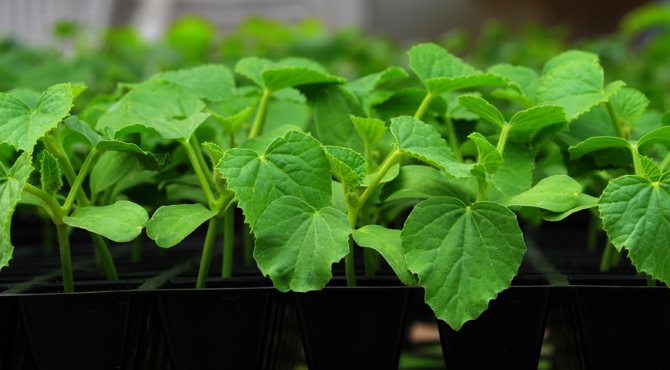

With the formation of a bush, Masha will be easier, since the whips do not differ in great length. But since this is a hybrid, and besides, it is also a bundle form of a cucumber, it is necessary to adhere to the following recommendations:
- in 4-5 of the lowest sinuses, all shoots and all existing ovaries are removed;
- higher along the stem, another 4-5 sinuses are counted and one ovary and one leaf are left in them;
- even higher are left, respectively, two ovaries and two leaves.
The stem of determinant cucumbers is not pinched, it has limited growth and ends on its own.
Cucumbers are often watered, taking into account the health of the plants, the air temperature, and the weather. In the heat, it will be necessary to increase the amount of irrigation, in cloudy weather, to reduce it. After watering - the obligatory loosening of the soil.
Cucumbers are fed about every 10-12 days. After planting at a permanent place, fertilizers are applied after 16-18 days, not earlier.
Mineral fertilizers and organic matter alternate, observing the dose. Cucumbers love nitrogen, but you cannot overfeed them, the green mass will grow to the detriment of the ovaries and the overall yield. In total, 4-5 dressings are carried out per season, the schedule is every 10-14 days.
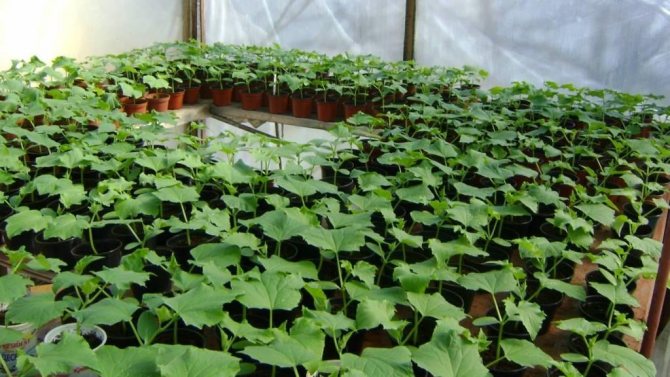

From folk remedies they use:
- infusions of herbs (insist on nettle, dandelion);
- yeast feeding.
Disease prevention is very important, during which the following activities are carried out:
- dusting cucumbers with wood ash;
- spraying with a pink solution of potassium permanganate;
- treatment with Bordeaux liquid.
If the manifestations of the disease have become noticeable, then it will be necessary to apply "chemistry": drugs Fundazol (from downy mildew), Hom (from anthracnose) and others. When using such formulations, it is required to act strictly according to the instructions, observe not only the doses of drugs, but also take into account the period when it is recommended to carry out the treatments.
For pest control, infusions of ash, tobacco dust, dandelions, soapy water are used. Chemicals are recommended for use when absolutely necessary, when folk remedies no longer help.
Masha F1 greens are collected when they reach a length of 8-9 cm, just such cucumbers are most suitable for pickling and preservation. It is advisable to collect the fruits every day so that the cucumbers do not outgrow, and also so that the next batches of zelents are formed on the plants faster.
In this hybrid, cucumbers are quite good keeping quality, they can be stored for up to 10-12 days without losing their presentation and taste. They are also suitable for transportation.
Care
Cucumber Masha, like other types of cucumber crops, loves moisture, so it should be watered often and abundantly. Watering is carried out early in the morning or in the evening, when the sun has almost gone down. Drip irrigation is ideal. With standard watering, soil moistening should be carried out every 2 days. Do not pour liquid under the root, so as not to damage it.
Proper care of cucumbers involves regular loosening of the soil. Do not cultivate too deeply, otherwise there is a risk of damage to the rhizome. The procedure allows you to organize proper nutrition and eliminate weeds. Hilling of the stems should be carried out 2 times per season. The first time when 4 leaves appear, the second when the plant reaches 20 cm in height.
Top dressing is carried out for the first time when 2 leaves appear. Then the procedure is repeated at intervals of 2 weeks.Top dressing is carried out with infusion of manure with ash.
To achieve good results, you need to carry out pinching on time, forming a crown. You need to pinch the shoots, whiskers and ovaries at the bottom of the plant. In the axils above 4 from the bottom of the leaf, you should leave 1 ovary with a leaf. In 10-12 sinuses, 2 ovaries with 2 leaves are left, respectively, in 12-16, 3 ovaries with 3 leaves are left.
Don't forget about the garter. For this, tapestries are used. This move avoids the appearance of fungal diseases.
Harvesting and storage
Cucumber is a vegetable that is eaten unripe. Therefore, you can collect greens at any stage of their development. The more often you pick cucumbers, the more new ovaries will appear.
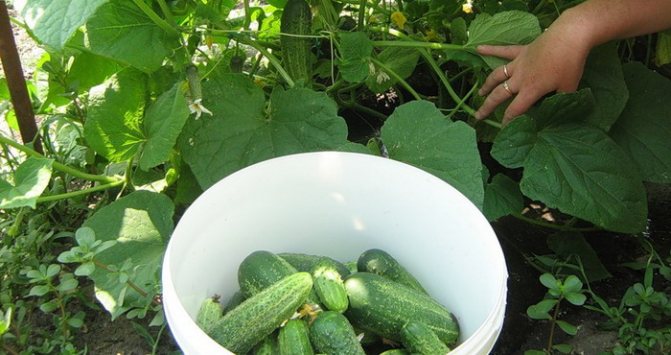

Cucumbers can be harvested every day
Cucumbers are harvested in the morning or evening. It is advisable to cut the fruits with a knife or secateurs, leaving the stalk on the lash. Certain difficulties with harvesting arise when growing in a spread, since you cannot turn the whips, crush the leaves, break the shoots.
Thanks to its thick skin, Masha F1 can be transported and stored in the refrigerator for 3-5 days. The variety is good in salting, canning, in summer, cucumbers are eaten fresh or lightly salted.
Diseases and pests
Cucumber Masha f1 is quite resistant to many diseases typical for cucumber crops, but if the rules of care are not followed, it can be exposed to white rot, anthracnose, downy mildew. For any of the above diseases, it is recommended to immediately remove the damaged shoots, treat the ground part with Bordeaux liquid or 1% copper sulfate solution. Treatment with the drug Fundazol is practiced.
Of the pests, the enemies of the variety are melon aphids, thrips, slugs, spider mites. Prevention is compliance with the rules of crop rotation. As a treatment, treatment with tobacco dust, pepper infusion, Fitoverm is used.
Advantages and disadvantages
Like any variety, cucumber Masha F1 there are advantages and disadvantages. The hybrid has the following advantages:
- It is especially early maturing, even among the early varieties.
- It has a high marketable yield of fruits (from 95%).
- The female type of flowering ensures the achievement of high yields, over 10 kg / m. sq.
- One knot can include about 7 ovaries, due to which the variety has a friendly fruiting.
- Fruits can be picked in the size of gherkins.
- Cucumbers They have excellent taste when used fresh and when canned.
- The hybrid is resistant to diseases, which allows you to achieve a good harvest.
- The fruits retain their properties during transportation.
Among the few shortcomings, it should be noted:
- hard skin that some may not like;
- lack of a rich, pronounced aroma;
- the tendency of fruits to outgrow, which necessitates daily harvesting;
- overgrown cucumbers there is a deterioration in taste.
Reference! It should be borne in mind that it makes no sense to collect seeds of hybrids, since their qualities are not passed on to future generations.
Watch the video! Cucumber Masha
How to deal with diseases of cucumbers?
The sooner the first signs of disease are noticed, the more likely it is to save the plant. Undoubtedly, timely preventive methods are the best way to protect your crop. But if the beds with plants signal the disease of cucumbers, and their treatment becomes inevitable, then every gardener would like to use the most effective method to save them.
The use of insecticides in the first stage of a crop disease is the most reliable way to protect plants. To prevent the appearance of anthracnose, the soil should be treated with a Bordeaux mixture before planting cucumber seedlings.In the absence of this tool, a suspension of bleach can replace it and provide a good service in preparing the soil for future cucumbers. The damaged bushes are uprooted and carried away from the garden, and the rest are treated with the drug "Ridomil".
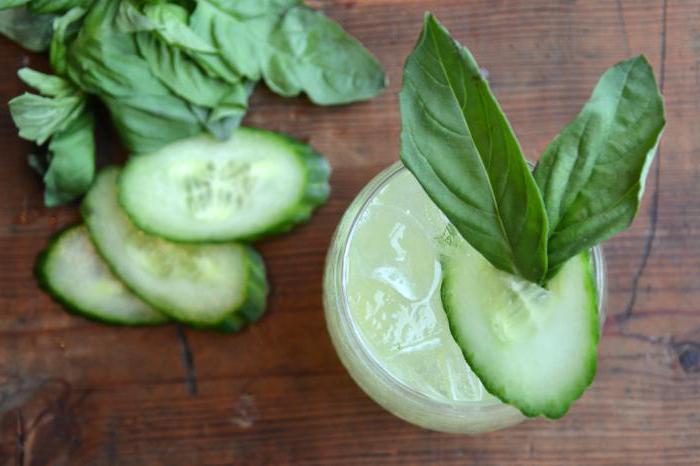

If root rot is found on one or more bushes, then they must be removed along with the soil and disinfected with the help of "Fitosporin" or folk remedies. Serum and soda are used for this purpose. The remaining plants should be carefully examined and some mechanical measures taken to protect them. The bushes need to be properly spud about 5-7 cm from the ground. This technique will allow the cucumbers to start up additional roots and form a new root system. For prevention, all plants need to be watered with one of the antifungal agents proposed above.
Preparing warm beds for cucumbers
With the organization of a warm bed, Masha's cucumber is able to give the gardener an even earlier harvest. An organic garden bed is a kind of equipped compost heap. The simplest option is a buried trench, into which organic matter of various types is alternately folded. Having worked hard in the fall, the gardener will significantly reduce his troubles in the new season. First, a warm trench will provide the cucumbers with proper nutrition throughout the season. Secondly, the soil in such beds is very loose and breathable. A place for arranging an organic bed should be chosen in areas where groundwater is deeper.
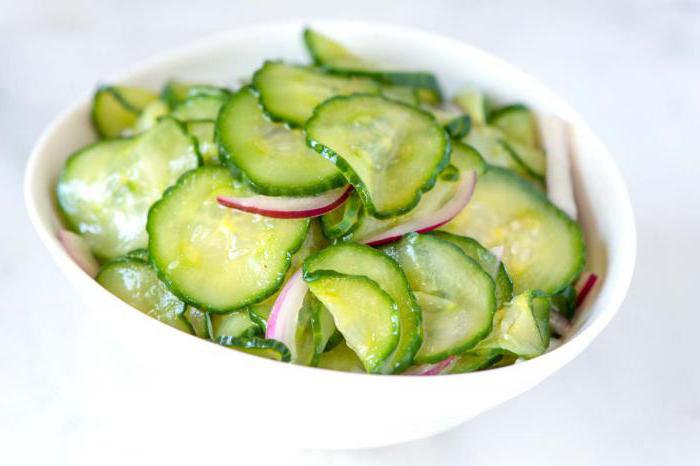

So that the work does not turn out to be in vain, and the plants get the maximum benefit, when creating a compost trench, you need to follow a few simple rules:
- Dig a trench 40-50 cm deep.
- The bottom layer is laid out from twigs, corn bushes and other large and decaying material. It will serve as a drain.
- Then they put softer organic waste, which is a natural fertilizer for plants.
- It is important to ensure that the contents in the pit do not dry out. If the autumn is dry, then the warm bed will have to be watered often.
- The topsoil is enriched with humus and covered with straw to retain moisture.



